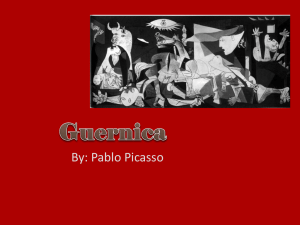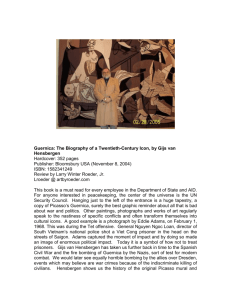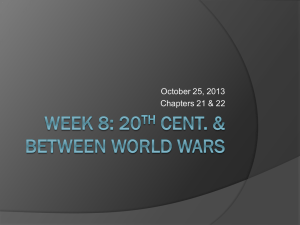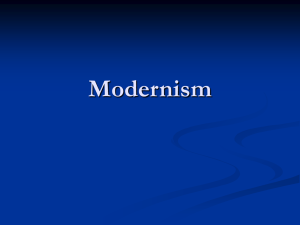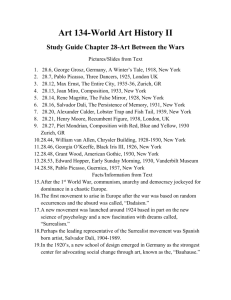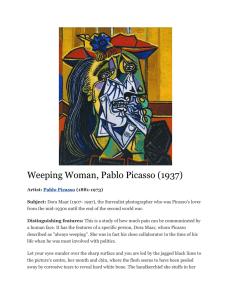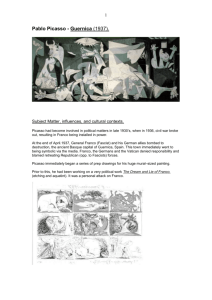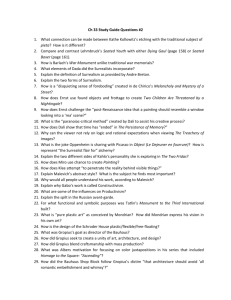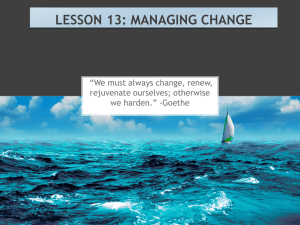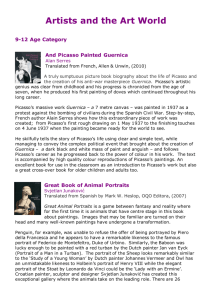Interactively Exploring Picasso’s Multi- dimensional Creative Process in Producing Guernica
advertisement
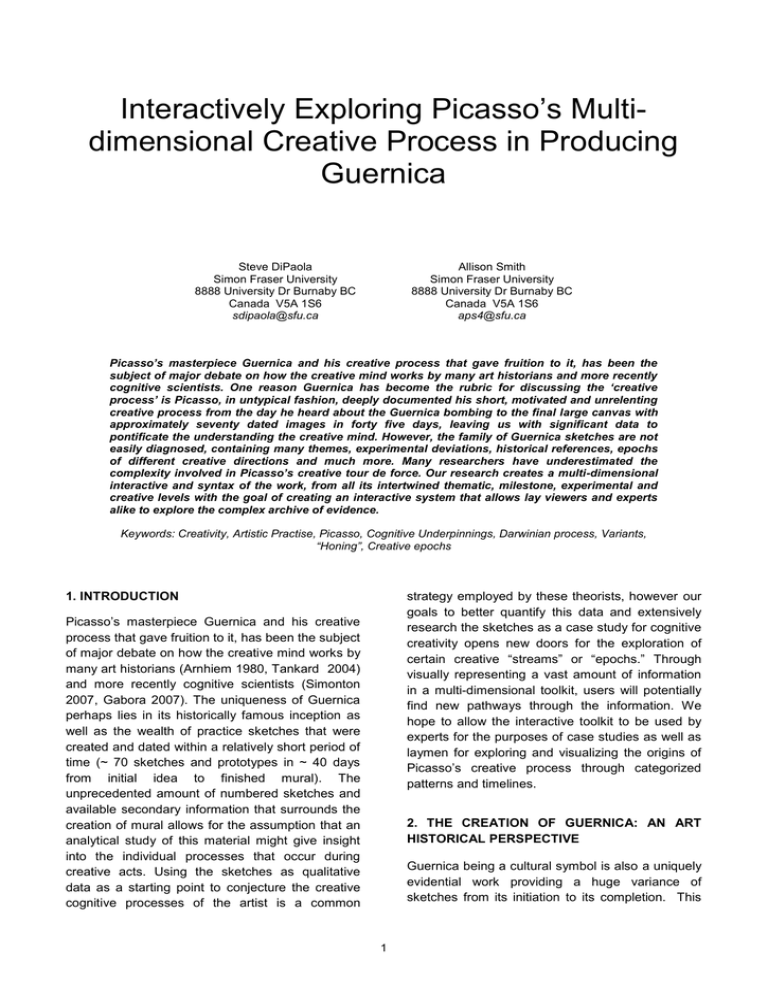
Interactively Exploring Picasso’s Multidimensional Creative Process in Producing Guernica Steve DiPaola Simon Fraser University 8888 University Dr Burnaby BC Canada V5A 1S6 sdipaola@sfu.ca Allison Smith Simon Fraser University 8888 University Dr Burnaby BC Canada V5A 1S6 aps4@sfu.ca Picasso’s masterpiece Guernica and his creative process that gave fruition to it, has been the subject of major debate on how the creative mind works by many art historians and more recently cognitive scientists. One reason Guernica has become the rubric for discussing the ‘creative process’ is Picasso, in untypical fashion, deeply documented his short, motivated and unrelenting creative process from the day he heard about the Guernica bombing to the final large canvas with approximately seventy dated images in forty five days, leaving us with significant data to pontificate the understanding the creative mind. However, the family of Guernica sketches are not easily diagnosed, containing many themes, experimental deviations, historical references, epochs of different creative directions and much more. Many researchers have underestimated the complexity involved in Picasso’s creative tour de force. Our research creates a multi-dimensional interactive and syntax of the work, from all its intertwined thematic, milestone, experimental and creative levels with the goal of creating an interactive system that allows lay viewers and experts alike to explore the complex archive of evidence. Keywords: Creativity, Artistic Practise, Picasso, Cognitive Underpinnings, Darwinian process, Variants, “Honing”, Creative epochs 1. INTRODUCTION strategy employed by these theorists, however our goals to better quantify this data and extensively research the sketches as a case study for cognitive creativity opens new doors for the exploration of certain creative “streams” or “epochs.” Through visually representing a vast amount of information in a multi-dimensional toolkit, users will potentially find new pathways through the information. We hope to allow the interactive toolkit to be used by experts for the purposes of case studies as well as laymen for exploring and visualizing the origins of Picasso’s creative process through categorized patterns and timelines. Picasso’s masterpiece Guernica and his creative process that gave fruition to it, has been the subject of major debate on how the creative mind works by many art historians (Arnhiem 1980, Tankard 2004) and more recently cognitive scientists (Simonton 2007, Gabora 2007). The uniqueness of Guernica perhaps lies in its historically famous inception as well as the wealth of practice sketches that were created and dated within a relatively short period of time (~ 70 sketches and prototypes in ~ 40 days from initial idea to finished mural). The unprecedented amount of numbered sketches and available secondary information that surrounds the creation of mural allows for the assumption that an analytical study of this material might give insight into the individual processes that occur during creative acts. Using the sketches as qualitative data as a starting point to conjecture the creative cognitive processes of the artist is a common 2. THE CREATION OF GUERNICA: AN ART HISTORICAL PERSPECTIVE Guernica being a cultural symbol is also a uniquely evidential work providing a huge variance of sketches from its initiation to its completion. This 1 Interactively Exploring Picasso’s Multi-dimensional Creative Process in Producing Guernica Steve DiPaola and Allison Smith unique opportunity to examine a complete case of creative processing was taken up by Arnheim (1980), in which he was perhaps the first to apply a psychological interpretation to Picasso’s process (Simonton 2007). His work focused on Picasso’s intentions when the artist was working out certain themes, focusing on details or trying to achieve a structural whole to the composition. Arnheim even considered the periods of time when Picasso took breaks from sketching and hypothesized the purpose of each sketch relative to its temporal proximity to the mural’s date of completion (Arnheim 1980). Some of the key findings Arnheim was able to establish were the themes of outcry, the variance of representation or “abstraction levels” of the symbols, as well as many other detailed explanations describing his interpretation of the decisions Picasso made on his path to completing Guernica (Arnheim 1980). was non-monotonic in that the sequence of sketches did not illustrate a linear progression towards the goal, thereby showing some sketches as missteps that were not used in the final painting and the selective nature of creativity (Simonton 2007). Gabora (2007) diverged in opinion as to whether the sketches indicated a non-monotonic creative process. Gabora’s response to Simonton is that Picasso’s process could not be considered a process of selective Darwinism due to the changes in fitness function. Each sketch or variant would affect how Picasso would precede in the creative process; no two sequential sketches can be compared to one another because the development of one particular sketch may be dependent upon its predecessor. Another critique Gabora offers is the problem with experimentation with the sketches and how this altered the participant’s judgments about the creative process. Gabora tried to use the sources in experimentation to disprove the selective process but found the task of organizing the sketches too difficult and possibly inciting skewed results due to the participants desire to have the strenuous task be completed (2007). 3. FROM ARNHEIM TO BIG-C CREATIVITY The more recent approaches to understanding the creative process have led certain cognitive theories to follow Arnheim and use the Guernica sketches as a source to establish a theory of the general characteristics of artistic creativity. In academic fashion, the analysis of the Guernica’s sketches has led to two largely opposing camps relating to the cognitive biological interpretations of the research, particularly referring to the work of Simonton and Gabora. 4. UNDERSTANDING UNDERPINNINGS THE COGNITIVITE The debate over cognitive qualities of the creative process as well as the wealth of commentary on Guernica’s development have led us to attempt to provide further insight into the connection between the two. The goal of the interactive toolkit is to help understand the cognitive processes that took place during the production of Guernica, as well as to present new ways of quantifying the wealth of research. To understand the cognitive underpinnings we set out to gather in depth analysis from Arnheim to understand a sketch by sketch description of the changes made by Picasso which included the suspected techniques he employed and meanings behind each sketches’ content. With Arnheim material as a base, we then analysed, categorized and incorporated additional art historical sources to understand the broader influences of Picasso’s creative process (Chipp 1988, Russell 1979, Granell 1980), such as artistic influences and the political and personal events at the time. By understanding the decisions Picasso made throughout the process we hope to present Simonton (2007) used the Guernica sketches to illustrate that each sketch could be considered as individual variants in which when analyzed and tested demonstrated a non-monotonic Darwinian process underlying Guernica’s development. Selective Darwinism is used to explain the variance of technique and content in the sketches as a blind experimentation (Simonton 2007). The sketches are variants that are influenced by the artist’s viewpoint and previous works; however some variants will lead towards the final goal, some will not (Simonton 2007). The creative product of the artists is rendered by the selection of certain variants that are generated throughout the creative process. In order to adjudicate which of Picasso’s sketches were successful, Simonton set out experiments to determine which sketches most closely resemble the final product via their “similarity” to the completed mural (Simonton 2007). His results concluded that Picasso’s process 2 Interactively Exploring Picasso’s Multi-dimensional Creative Process in Producing Guernica Steve DiPaola and Allison Smith each sketch’s purpose or function in relation to the final painting and to answer questions such as: Were certain sketches dead ends? Is each individual sketch created for the purpose of the end project (a singular painting)? By answering these questions, we hope to give some general features of Picasso’s creative process. Our main goal however was to systematically categorize all the data streams on this work into an open ended interactive system or toolkit that allow experts and lay persons to move through the multi-dimensional data, allowing them to come to their own conclusions via exploration through the data space. historical, conceptual, symbolism) outside of the scope of the 70 sketches. The method involved systemically organizing/filtering/tagging the qualitative narrative into a database in order to categorize the sketches with tags, captions, images, and timelines. We started developing a working framework for organizing the research – the collected data was broadly divided into three main modes of viewing the material: the process of making the artwork, symbolism, and the history surrounding the development of the painting. Each category was then further divided accordingly: (i) Process. This pathway refers to the step by step development of the creative process. The information is presented in a timeline that matches the historical dates of each sketch. The information can be viewed within a narrow scope which only displays the analysis of the content between the approx. 70 sketches. The broad scope includes other artworks that preceded and/or were completed after Guernica but are still considered to have influence the progression of Picasso’s creative process of Guernica. (a) Symbol development. Refers to a particular character, group of characters or object that has been distinguished mainly by Arnheim. (b) Theme development. The sentiments or emotional themes that are expressed or intended to be conveyed through the symbols. (c) Creative epoch. A singular or groups of sketches where Picasso implemented a particular technique to move forward in the creative process. Either a problemsolving exercise or a signal of a new approach to the task at hand. One exception is the extension of theme creative epoch that describes the development of a new task. (d) Re-emergence. The themes and characteristics of Picasso’s and other artist’s artwork that are present in the sketches leading up to Guernica. (ii) Symbolism. Interpretations of the content of the sketches according to different historical theorists. Some interpretations may be viewed as possibly influencing the content of the sketches while others may be restricted to a receptive interpretation. Including: (a) Corrida. Interpretations of the role of Spanish bullfighting as a symbol of Spanish identity. (b) Adoration of the Magi. Characters are viewed in the context of religious symbols and practice that were present during Picasso’s life and predominant in pre-civil war Spain. 5. QUANTIFYING GUERNICA: INTENDEND CONSTRUCTION AND RESEARCH METHOD The project began with the selection of a specific research methodology to systematically collect, analyze and re-catalogue the multivalent and organic visual, critical and informational material into a more coherent knowledge space. To achieve this level of rigor, we used a known methodological approach – Poetics. Poetics starting with Aristotle's Poetics (Aristotle 1961) and has become a modern methodology for study literature, drama and art from a formalist perceptive. The methodology uses "the systematic review, analysis, and alignment (or perhaps 'synthesis’) of the expressed poetics of expert practitioners" (DiPaola 2009). For our work we used more modern techniques as described in David Bordwell's "Poetics of Cinema" (Bordwell 2007). In a strong statement on the value of poetics as scholarship Bordwell states: "Poetics’ derives from the Greek word poiêsis , or active making. The poetics of any medium studies the finished work as a result of a process of construction—a process, which includes a craft component, the more general principles according to which the work is composed, and its functions, effects, and uses. Any inquiry into the fundamental principles by which a work constructed can fall within the domain of poetics." As a foundation, the sketches themselves were the main “atoms” of the project, and were categorized with dates of creation, titles, and tagged on many functional and sematic levels including initially the themes and symbols they contained within them (eg. theme: ‘horse’, ‘mother and child’, symbols: ‘outcry’). The focus of the research was to understand the changes or differences between each individual sketch, first by cataloguing the information given by Arnheim and other scholars as well as gradually including information (e.g. 3 Interactively Exploring Picasso’s Multi-dimensional Creative Process in Producing Guernica Steve DiPaola and Allison Smith (c) Crucifixion. The scene and characters of Guernica are viewed as an interpretation of classic crucifixion scenes. (iii) History. The political and social events that sparked Picasso’s motivation for the painting and influenced the content. (a) World War II and the Spanish Civil War. The historical events that might have motivated Picasso to make his painting: the bombing of the city of Guernika as well as the Spanish Pavilion. (b) Personal life. The romantic relationships and political views that influenced Guernica’s content development of symbol, theme, and re-emerging influence. However, we have also constructed a timeline for “creative epochs” which are our own interpretations of how to quantify the comments Arnheim made about Picasso’s creative decisions while making Guernica. 6. THE TOOLKIT The toolkit allows for each category to be narrowed according to the keyword selected from the drop down menu. Once a keyword is selected, in our example in figure 1 - “Horse”, the toolkit highlights the timeline of all the sketches related to the keyword (in red in the figure) and displays various captions for each highlighted sketch. For example, if the user requires to focus on the development of a particular symbol in Guernica, for example “the horse”, they select the keyword from the drop down menu and they are presented with the sequence of all horse sketches as well as information about the development of the symbol from sketch to Guernica’s completion. However, the navigational keywords that are utilized in the toolkit are more specific and will allow the user to pick an area of focus within these broader categories. As an additional feature the user has the option to navigate through the material by viewing multiple timelines that display the sketches sequentially according to a particular symbol, theme, or “creative epoch.” Certain timelines are more fully realized by other art historians, such as the Figure 1: Screenshot of the Toolkit 4 Interactively Exploring Picasso’s Multi-dimensional Creative Process in Producing Guernica Steve DiPaola and Allison Smith Currently, the toolkit only displays information relating to narrow process, i.e. symbol, theme development, and creative epoch. The keywords available in the drop down menu are those that relate to symbol development whereas the theme development and creative epochs are only displayed as captions corresponding to each individual sketch. However, the toolkit is data driven from our updatable database, which allows us or experts to add new keywords and/or new full scenarios, which fosters planned out or on the fly debate based and educational demonstrations. Any set of selected sketches (in red in figure 1) either via premade keywords from the database or selected live, can then be played in slideshow mode at different speeds and looping options facilitating automatic demonstrations where an expert can moderate their new slide show display. However, to validate the tools usefulness, we then made a concerted effort to work in the cognitive creativity research space, using the tool to explore that data with regards to the aforementioned Guernica creativity debate. We present three examples of the “creative epochs” we found in the Guernica explorations that show creative patterns apparent in Guernica that could be applied to broader theories of creativity. 7. RESULTS OF CREATIVE PROCESS Quantifying the vast amounts of material was a large task that provides perhaps a more objective presentation of the data, containing several interpretations of the content as well as Picasso’s process, and the option of reliable and categorized data according to several different aspects commonly found with in an artistic work. Figure 3: Sketch 4 7.1 Creative Epochs (1) Form and emotion. In order to find the most appropriate way to express a particular theme Picasso would experiment with different symbols to express the same theme. A more notable occurrence of this epoch is in Figure 2 where Picasso sketched both the horse and bull with stretched necks pointing upwards expressing the theme of outcry. Arnheim noted this as Picasso’s consideration of the horse being the chosen symbol to express human sentiments or theme because it is “better suited for the task anatomically than the stocky bull” (Arnheim 1980 p.48). (2) Distortion via the norm. Picasso used realism to study the natural elements of a horse. He first drew a sketch in a very simplistic way that did not seem to be an intentional representation of what he was planning for the final product. Rather, the act of Figure 2: Sketch 11 5 Interactively Exploring Picasso’s Multi-dimensional Creative Process in Producing Guernica Steve DiPaola and Allison Smith 7.2 Analysis drawing the simplistic horse as well as viewing a realistic source was a technique to help him understand distortion, such that “All distortions must be readable to the perceiver as deviations from the norm” (Arnheim 1980 p. 36). Findings (1) and (2) both indicate possible considerations for the methodological approach of using the source material. In methodological practices arguments have been generated not only over whether the sketches belong within the same fitness function (Gabora 2007) but ultimately how to determine which aspects or items should be categorized as a single variant of experimentation. Finding (1) may be considered as two separate variants whereas Finding (2) may be combined with other distorted sketches of the horse given the evidence suggesting this sketch was an exercise or basis to build a distorted representation in later sketches. Findings (2) and (3) also raise another methodological concern, is “similarity” a good marker of progression in the creative process? Picasso as well as Arnheim’s reflection on the particular technique in Figure 3 emphasizes that distortion is the intended presentation of the horse in the final mural and the simplistic horse is merely a means to achieve his local goal. It would appear obvious that sketches such as Figure 3 would not represent a progressive step towards the finished goal if it is only measured by how similar in representation they are to the end result. It should be viewed as a technique employed to achieve a short term goal of creating distortion or even as a necessary technique or a step towards being prepared to develop distortions the sketch. The previous inclusion of these sketches in experimentation (Simonton 2007) being evaluated by similarity may be unwarranted especially when considering Findings (3) clearly indicate the development of a new project. To conceive every sketch as Picasso directly attempting to create an image that is similar in representation to the desired end product may seem like a logical step but perhaps inaccurately describes the techniques employed by visual artists to problem solve and the organic development of new projects intertwined within progressive developments. Figure 4: Sample of weeping women from Sketches 4661 (3) Extension of theme. These sketches (Figure 4) represent possible progressions towards the later painting of the Weeping Woman (done in October 1937) and do not reflect Picasso actively working towards Guernica. The last sketches appear to indicate the development of a different project rooted in the sketches of Guernica. This seems to support Picassos sense that all art is research and that he can work working both simultaneously on a incredibly dedicated piece like Guernica at the same time beyond it ( and before it), with his many intertwining art research pursuits and experimentations over his artistic development. 8. POTENTIAL USES FOR TOOL By presenting this deep, intertwined and organic material in a new multi-dimensional visual, textural and interactive format which can connect the relationships between the sketches in a quick and effective manner, we believe our interactive toolkit 6 Interactively Exploring Picasso’s Multi-dimensional Creative Process in Producing Guernica Steve DiPaola and Allison Smith can be used for exploration, reflection, experimentation and education. The toolkit can be used in library, gallery and museum settings (online or site specific) to educate those interested in the historical and creative aspects of Picasso’s creative process during the making of Guernica. It allows an interactive user to explore at their own pace and in any direction they choose, this magical 40 days in the artistic and creative life of Picasso where from the moment he heard about the bombing, till it’s completion, he worked ravenously on one of the most celebrated art pieces of our day, leaving uncharacteristic (for him) notes and evidence along the way. adjustable solution to such concerns as well as hopefully incite new experimentations. We believe that the tool has potential for experts to explore the dataset, record new paths through the work, refine and annotate them and then present them to other scholars or to an audience to explain a new theory or demonstrate a conjecture. This can be done on the fly or in a local (ie. to a museum) or global peer reviewed way – allowing personal databases or agreed upon officially databases to be viewed by simply linking to them. We also feel that it is useful to a lay person say in a museum kiosk to both explore preconceived paths from the museum staff and global experts as well as explore the work in an open ended way. We are currently refining the system, showing the prototype to scholars (including Gabora) and intend to bring it out as a specific tool for exploring Picasso creation of Guernica and as a technical prototype for other multi-dimensional explorations through complex visual and textual knowledge spaces. Aristotle. (1961). Aristotle’s Poetics. (S. H. Butcher, Trans.) (First Edition.). Hill and Wang. Acknowledgements We would like to thank Faris Chebib for working with us on some of the initial ideas and to Jordan Wong for his programming work on the toolkit. The work was partially supported by Simon Fraser University’s Cognitive Science Chair Research Award as well as Natural Sciences and Engineering Research Council of Canada. REFERENCES Arnheim, R. (1980) The genesis of a painting: Picasso's Guernica. University of California Press, Berkeley. Bordwell, D. (2007). Poetics of Cinema (1st ed.). Routledge. Chipp, H. B. (1988) Picasso’s Guernica: history, transformations, meanings. University of California Press, Berkeley. DiPaola S, (2009) Exploring a Parameterized Portrait Painting Space, International Journal of Art and Technology, Vol 2, No 1-2, pp 82-93. Gabora, L. (2007) COMMENTARIES: Why the Creative Process Is Not Darwinian: Comment on "The Creative Process in Picasso's Guernica Sketches: Monotonic Improvements versus Nonmonotonic Variants", Creativity Research Journal, Vol. 19, pp. 361-365. In terms of relating the material to cognitive research, we are hoping to provide the relevant research for cognitive theories to not only pontificate on their own description of the creative process but for new experimentation as well. The usefulness of the interactive toolkit as medium is in its ability to provide the information in both an objective (quantifiable) and interpretive matter, but also its ability to be customized. Researchers could alter the toolkit according to their needs, possibly demonstrating different timelines and focusing on specific objects or information. The need for such a tool could arguably be demonstrated through Gabora’s concerns about the difficulties of organizing the source material for experimentation in her commentary on Simonton (2007). The practicality of the toolkit would offer an open and Granell, E. F. (1980), Picasso’s Guernica: the end of a Spanish era. UMI Research Press, Michigan. Russell, F. D. (1979), Picasso’s Guernica: the labyrinth of narrative and vision. Allanheld and Schram, New Jersey. Simonton, D. (2007) The Creative Process in Picasso's Guernica Sketches: Monotonic Improvements versus Nonmonotonic Variants, Creativity Research Journal, Vol. 19, pp. 329-344 Tankard, A. (2004) Picasso's Guernica after Rubens's Horrors of war: A comparative study in three parts-- iconographic and compositional, stylistic, and psychoanalytic. Art Alliance Press. 7
